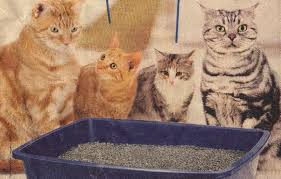Litter Box Problems in Cats
First, let’s get some housekeeping out of the way. Keep this handy if you think your pet might need to come see us around the holidays. We will use the following holiday hours:
Close early November 25, probably around 4, and won’t reopen until Monday, November 30
Close at noon on December 23, remain closed through Monday and reopen at noon on Tuesday, December 29
Close at 5 p.m. on December 31, reopen Monday, January 4 at 9 a.m.
Other upcoming events to pay attention to:
Canine massage by appointment: October 30 and November 20, both Fridays. Call 816-331-1868 to schedule your dog for a relaxing and therapeutic massage.
There will be NO seminar in October, Dr Leonard’s weekend schedule is just too full. Sometime in November or December, we may be having a class with a nominal cost, for pet first-aid kit construction that you can take home for personal use at the end of the class. We’ll let you know!
Dr Leonard recently took a continuing education course in Rehabilitation techniques. We can now offer even more advice on how to help your weak, injured, or wobbly pet strengthen and regain function.
MY CAT WON’T USE THE LITTER BOX!

And now for the main event! This month, our discussion will be on litter box refusal issues in cats. So if you only have dogs, well, sorry. But cats are people, too.
First, any cat that has stopped using a litter box should have a full medical evaluation by your vet including blood work and urinalysis to rule out organ problems, hormonal imbalances, or infections that may cause issues relating to the litter box. If all that testing comes back normal, here is a list of recommendations for things to try to resolve the cat’s dislike of the litter box.
- Use unscented litter. Since cats dig in their boxes, some of them aren’t crazy about the perfume that assails their nose and will then avoid digging or even stepping in the box. This also means not adding strong-scented materials or cleaning products to their box.
- Provide enough litter boxes. Experts recommend one per cat, plus at least one extra. Some cats prefer to urinate in one and defecate in another. Some cats won’t use a box another cat has used. Not all boxes should be in the same room.
- Clean the boxes at least every day. See number 2. (the list, silly…not in the box)
- Use scoopable litter. By having a clumping litter, it is easier to remove urine and keep the box cleaner and better smelling, and thus more attractive to the cat.
- Don’t put food and water near the boxes. Would you want to eat your dinner in the bathroom?
- Try different textures or depths of litter. Some cats prefer finer or coarser textures. Some like deep enough litter for good digging, others don’t like to sink in. While experimenting, try using multiple disposable foil baking pans as boxes until you determine what your problem child prefers, then you can switch to a more permanent solution.
 Some cats may even prefer shredded paper, sand, potting soil, potty pads, or an empty box. Be creative. Always provide a litter they are willing to use sometimes, but add boxes with choices. A cat that perches on the edges of the box is telling you they don’t like how the litter feels on their feet.
Some cats may even prefer shredded paper, sand, potting soil, potty pads, or an empty box. Be creative. Always provide a litter they are willing to use sometimes, but add boxes with choices. A cat that perches on the edges of the box is telling you they don’t like how the litter feels on their feet. - Try different locations. Put a box where they inappropriately eliminate, then once they are using it, move it a few inches a day to a better location. Avoid busy locations, places other cats attack them, or areas difficult for the cat to get into. You don’t want to use a restroom with no door next to a busy sidewalk. Neither does your cat.
- Take the cat’s physical abilities into account. Old arthritic cats may not feel it’s worth their time to go down to the back corner of the basement to eliminate when that throw rug is RIGHT HERE. Some cats may have difficulty getting over a high sided box, or balancing in a box that is too small. Larger cats may need large under-bed storage boxes instead of official litter boxes for enough room to comfortably use as their bathroom.
- Find a way to keep your cat from eliminating in the wrong place. Clean the soiled area well with an enzymatic cleaner that penetrates through all affected surfaces to remove odor. Cover the area with an upside-down plastic carpet runner (nubbins up) or piece of furniture. Keep the cat out of that room. Confine the cat to an easily cleaned area with the box, or even a large dog kennel, until they are using a box regularly. If they go on laundry, don’t leave it lying around unattended. Try to break the habit by removing that choice.
- Avoid enclosed spaces without good ventilation. Do you prefer a large, clean, open bathroom with a fan over a dirty, tiny port-a-potty? So does your cat. That means removing a cover over a box may be all it takes for some cats to use it again. Uncovered boxes are best.
- Evaluate multi-pet interactions. Is a bully cat or dog in your household harassing the cat while it is trying to use the litter box? In some cases, you may find it best to re-home a pet to settle down the household dynamic. Just be honest with the new owners if you are re-homing the problem eliminator and explain why you think a new home might solve the problem.
- Never punish your cat, or do unpleasant things to it, around the litter box. If your cat has to receive medications, don’t corner it next to the box to administer it. Try not to have negative associations with the litter box or its vicinity.
 Solving inappropriate elimination problems in cats takes time and sometimes extensive investigative work. But in most cases, if you have the desire to solve the problem, you can. Even the long-haired breeds, notorious for being very picky about their litter boxes (wouldn’t you be, if you had hair that dragged in the toilet and had to clean it by licking it?), can learn good habits. Jump on this investigative work as soon as possible when you discover a cat isn’t using the box, as long-term habits are harder to break. Good luck!
Solving inappropriate elimination problems in cats takes time and sometimes extensive investigative work. But in most cases, if you have the desire to solve the problem, you can. Even the long-haired breeds, notorious for being very picky about their litter boxes (wouldn’t you be, if you had hair that dragged in the toilet and had to clean it by licking it?), can learn good habits. Jump on this investigative work as soon as possible when you discover a cat isn’t using the box, as long-term habits are harder to break. Good luck!









October 18th, 2015 at 5:07 am
got a new fangled litter box and they wont have anything to do with it. have fed them in it added treats used some old feces in it used the same litter let their old box get really dirty they wont even hang out in there tho they will sleep in baskets boxes and cram themselves in to other things to hang out its called the litter robot a big sphere on a stand I havent even turned iti on yet . any ideas ?
October 19th, 2015 at 8:50 am
As stated in the newsletter, many cats do not like a covered litter box, which is what it sounds like you have. Also, food in the litter box is a bad idea, as also stated in the newsletter. If this is an electrical device, it may have some humming or other electrical energy they can detect that you cannot. I think you’ll just have to stick with the old-style boxes.